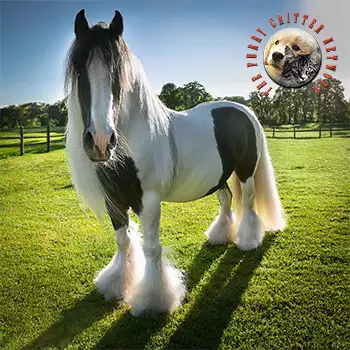General Description
The Gypsy horse is widely known for its piebald, or black and white pinto coat color, a common but not sole coloration for the breed. However, Gypsy horses may be of any coat color; none of the breed registries incorporates a color requirement into its breed standard. Since the breed's origin is British, color names are typically given in British English in all English language registries, even in the United States, such as the piebald and skewbald color descriptors added to the tobiano spotting patterns of the Gypsy. Another British word used to describe a particular color pattern is blagdon, describing "a solid color" with white "splashed up from underneath".
Feathering, long hair starting below the knee of the front legs and the hock of the hind legs and running down the leg to flow over the front and back of the hooves, is a highly valued attribute of the Gypsy Horse. Silky straight hair and feather are desirable, though somewhat coarser and even wavy hair and feather are permitted. Profuse feather is an integral part of the definition of a Gypsy Horse and most registries require it.
A Gypsy Horse's facial profile should be straight, neither overly dished nor roman nosed. A "sweet" head, more refined than that of most draft horses, is desired. The neck is strong, muscular, and of medium length "with a throat latch slightly deeper than lighter breeds". The chest should be broad, deep, and well muscled. Withers are "well rounded, not high and fine, i.e., hardly noticeable". The back is to be short coupled with well sprung ribs and a deep heart girth. The length of line of the belly should be twice that of the topline of the back and the horse should not appear 'wasp waisted'. The Netherlands studbook registry rules for vanner and cob types have breed standards desiring strong, well-muscled builds with abundant feathering similar to that of the registries in English-speaking nations. The "grai" is classified as a lighter and more refined riding type.
Strong hindquarters define the breed as a small draft horse, "designed for strength and power, but with class, presence and style." They are sometimes described as having an "apple butt" as the croup is well rounded and "very generous, smooth and broad". Bone in the legs should be heavy, clean, and flat. The hind legs of the Gypsy Horse should display proper angulation for a pulling horse, though generally not to the degree found in larger feathered draught breeds such as the modern Shire and Clydesdale. The cannon bones of a Gypsy Horse's hind legs, when viewed from behind with the horse set up squarely, appear parallel, and the entire leg is turned outward. This conformation is not to be confused with legs which are cow-hocked, where the cannon bones are not parallel to one another.
The Gypsy horse has distinct gaits. The stride should be correct, supple, and powerful. Showing good impulsion from behind, demonstrating powerful drive. Flowing, effortless in appearance. The horse's movement should be "natural, not artificial. Some have higher knee action than others, it's way of going can vary from short and economical to longer, reaching strides."
The Gypsy horse should be a "strong, kind, (very) intelligent partner that works willingly and harmoniously with its handler. They are also described as mannerly and manageable, eager to please, confident, courageous, alert, and loyal with a genuine sociable outlook. The Gypsy Horse is renowned for its gentle, tractable nature and sensible disposition."






